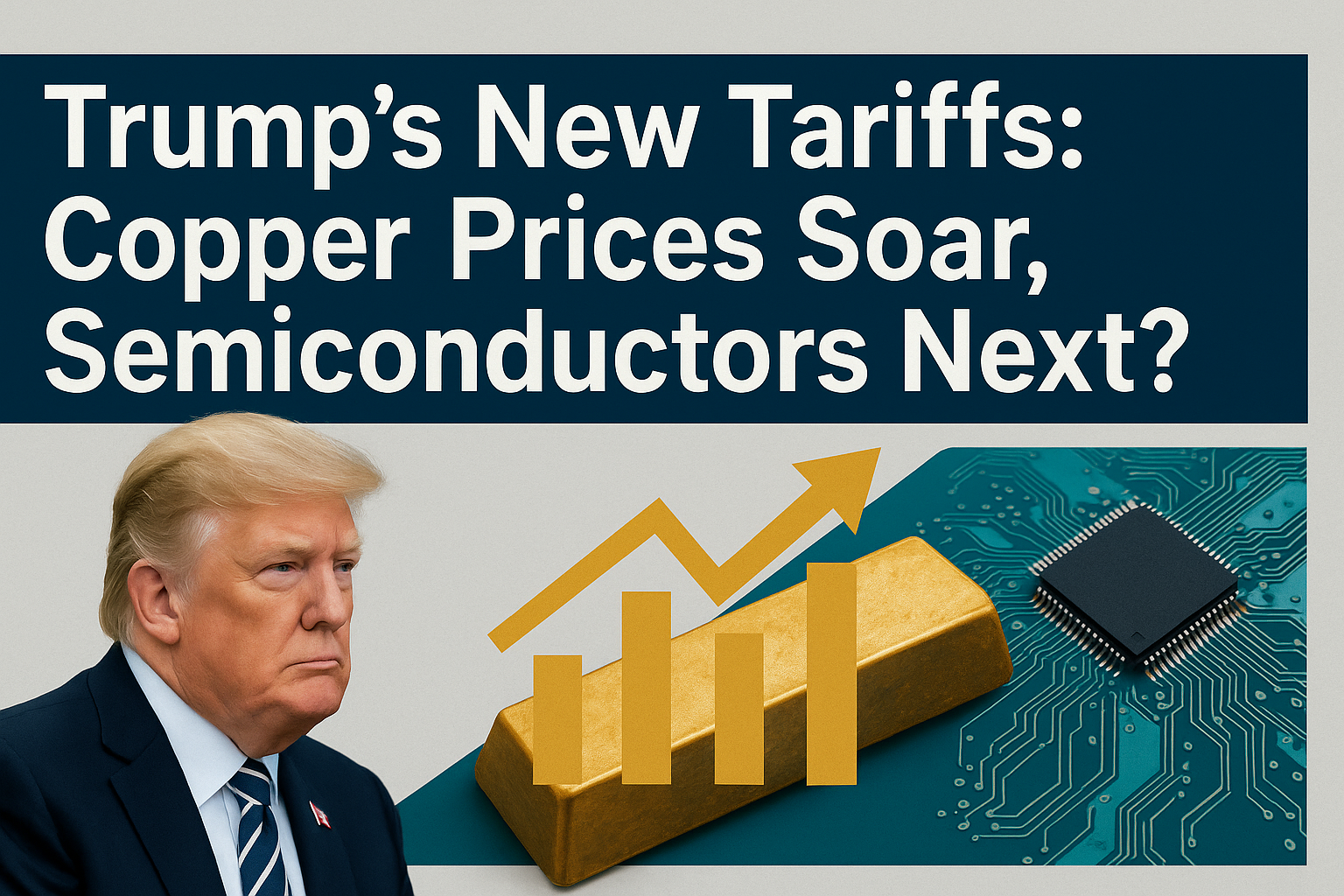Trump’s New Tariffs: Copper Prices Soar, Semiconductors Next?
Intermediate | July 13, 2025
✨ Read the article aloud on your own or repeat each paragraph after your tutor.
A New Tariff Shakes the Market
Trump Copper Tariffs Spark National Security Debate
President Donald Trump has announced a major new tariff: a 50% tax on all imported copper. This new rule is set to begin on August 1, 2025. Trump explained that this decision is based on a “robust national security assessment.” He stated that copper is incredibly important for many critical industries, including making semiconductors, aircraft, and defense systems. In fact, it’s the second most-used material by the Department of Defense.
Why Copper Matters and What Happened Next
Copper’s Role in Technology and Infrastructure
Copper is vital for modern technology and infrastructure. It’s found in nearly everything electronic, from the chips in our phones to the wires that power our homes. This importance is why the tariff announcement had such a quick impact.
Market Reactions to the Trump Copper Tariffs
Immediately after the news, US copper prices surged. Futures, which are agreements to buy or sell copper at a future date, rose by over 10%. Overall copper prices first jumped by 13%, and then increased another 2.62% shortly after. Analysts believe that by August, US consumers could pay around \$15,000 per metric ton for copper, which is much higher than the current global average of about \$10,000.
The United States currently imports almost half of its copper supply.### Copper Imports and the Challenge of Domestic Production In 2024, the biggest suppliers were Chile (51%), Canada (31%), and Mexico (7%). Experts warn that trying to produce enough copper domestically to meet the country’s needs could take many years, making it a difficult challenge.
A Broader Trade Strategy
From Copper to Cars: A Wide-Ranging Tariff Agenda
This copper tariff is part of a larger plan by the Trump administration to increase trade measures in his second term. Between January and April 2025, the average US tariff rate has increased significantly, from 2.5% to an estimated 27%. Other existing tariffs include 50% on steel and aluminum, and 25% on imported cars.
Reciprocal Tariffs Target Asia
The administration has also announced “reciprocal tariffs” – taxes on imports that match taxes placed on US goods by other countries. These new tariffs, ranging upwards from 25%, will apply to 14 countries, mostly in Asia, and will also start on August 1. Some see these tariffs as a way to pressure nations to reduce their trade with China.
More Tariffs Coming: Semiconductors and Pharmaceuticals
Beyond copper, President Trump has also indicated plans to impose high tariffs on semiconductors and pharmaceuticals soon. Tariffs on drug imports could even reach 200%, though a one to one-and-a-half year period might be given for pharmaceutical companies to adjust. Investigations into these sectors are already underway to support these future tariff decisions.
Predicted Consumer and Legal Impact of Trump Copper Tariffs
Economists and industry experts predict that these tariffs will cause consumer prices to rise for goods that contain copper,### Predicted Consumer and Legal Impact of Trump Copper Tariffs
Economists and industry experts predict that these tariffs will cause consumer prices to rise for goods that contain copper, such as appliances, electronics, and vehicles. This could lead to inflation and higher costs for important infrastructure projects like improving the electric grid. China has publicly disagreed with these actions, stating that “trade wars and tariff wars have no winners.” Meanwhile, legal challenges against the use of the International Emergency Economic Powers Act (IEEPA) for such broad tariffs are ongoing, with important court discussions scheduled for July 31, 2025.
Vocabulary
- Tariff (noun): A tax or duty to be paid on a particular class of imports or exports.
*Example: “The government announced a new tariff on imported goods.” - Surged (verb): Increased suddenly and powerfully.
*Example: “After the announcement, the stock market surged by several points.” - Semiconductors (noun): Electronic components that control the flow of electricity in devices like computers and phones.
*Example: “Many modern electronics rely on advanced semiconductors to function.” - Critical (adjective): Of extreme importance; vital for the success or operation of something.
*Example: “Clean water is critical for public health.” - Anticipate (verb): To regard as probable; expect or predict.
*Example: “We anticipate that the weather will improve by tomorrow.” - Escalation (noun): An increase in the intensity or seriousness of something.
*Example: “The constant arguments led to an escalation of the conflict.” - Reciprocal (adjective): Given, felt, or done in return.
*Example: “She offered her help, hoping for a reciprocal gesture in the future.” - Domestic (adjective): Relating to one’s own country; not foreign.
*Example: “The new policy aims to boost domestic production.” - Inflation (noun): A general increase in prices and fall in the purchasing value of money.
*Example: “High inflation can make everyday goods more expensive for families.” - Opposition (noun): Resistance or disagreement, typically expressed in argument.
*Example: “There was strong opposition to the new housing development.”
Discussion Questions (About the Article)
- What is the main reason President Trump gave for placing a tariff on imported copper?
- How have US copper prices changed since the announcement?
- Which countries are the main suppliers of copper to the United States?
- Besides copper, what other products might face high tariffs soon?
- What are some predicted economic impacts of these tariffs on consumers?
Discussion Questions (About the Topic)
- Do you think tariffs are an effective way to protect a country’s industries? Why or why not?
- How might increased costs for materials like copper affect everyday life for people?
- What are the pros and cons of relying on other countries for essential materials?
- If you were an economist, what advice would you give the government about trade tariffs?
- China says “trade wars have no winners.” What do you think this statement means?
Related Idiom
A double-edged sword
Meaning: Something that has both advantages and disadvantages.
Example: “While the new tariffs might protect some industries, they could also be a double-edged sword, leading to higher prices for consumers.”
📢 Want more tips like this? 👉 Sign up for the All About English Mastery Newsletter! Click here to join us!
Join the English Mastery Club — your place to practice, grow, and connect with others mastering English just like you!
Follow our YouTube Channel @All_About_English for more great insights and tips.
This article was inspired by: Reuters, July 8, 2025


